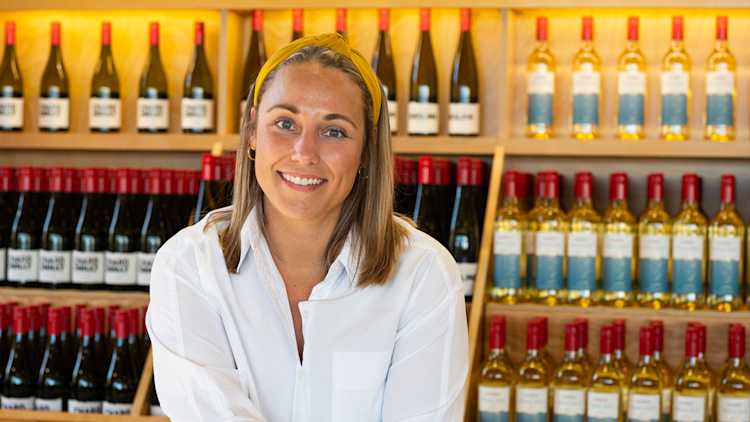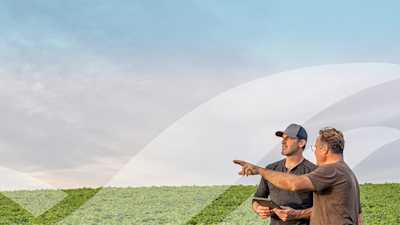Three key transition lessons from a young farmer

Since the family vineyard started in 2011, Geena Luckett of Luckett Vineyards in Wallbrook, N.S. — about 85 kilometres northwest of Halifax — always helped. And when a full-time job as the events manager opened, she applied and was the successful applicant. Since then, the vineyard has been on a trajectory of growth and managing transition to Geena becoming co-owner. Geena, who spoke recently at an FCC Young Farmer Summit, shares how she’s navigated change and continues to lead the family business through growth and expansion.
1. Stay constant
The vineyard has changed quite a bit since its establishment. It was steady and gradual growth.
In 2011, we opened the doors and started selling approximately 3,000 cases, and our grape crush pad turned into a bistro space for the summers. Our wine shop and tasting bar lived amongst the tanks. We were busting at the seams quickly.
Over the next 10 years, we expanded the number of acres under vines. In 2014, we sourced some significant contracts with local growers to help our grape supply, then started expanding the guest space by adding some new patio areas. We expanded to add a full wine shop and tasting bar the following year. We also moved production and storage to an offsite warehouse. By 2016, we sold about 10,000 cases annually and continued with modifications to our estate property. The most recent thing was a huge project to enclose most of our bistro space to stay open to the public year-round. Despite weather challenges, we have sold about 16,000 cases annually, with plans to reach 20,000 cases in the coming years.
I don’t think there was any pivotal moment in time where a drastic change was needed. Steady growth meant we, fortunately, could take our time identifying what needed to happen. We did have to formalize things quickly at the beginning, however. My dad is a jack-of-all-trades. He could do much of it himself at the beginning – we both remain very hands-on owners – but the continued growth meant we had to add to the team.
Being seasonal has many challenges. But in this instance, it was beneficial as we typically made big growth changes over the winter when we were closed, then evaluated our needs, partnerships, suppliers and hiring needs in spring before opening each year. This approach meant we weren’t rushed in our audits or defining our needs, and it also provided us time to determine what worked/didn’t work from the season before.
2. Create boundaries during the transition
I became involved in the business when I started helping on my days off once we opened to the public in 2011. A year later, when the events manager was moving out of province, I applied for that vacancy. I spent the next four years learning the business from all departments. In 2016, my dad identified that the growth we had experienced required someone to oversee operations and lend him a hand. I was promoted to general manager at that time.
In 2018, we started discussions around transition to ownership, which we both expected to happen gradually over a longer term. However, in 2020, my dad saw an opportunity to start a new business overseas, so our transition plan was expedited. Today, I am a part owner of Luckett Vineyards and am responsible for all operations.
One of the biggest challenges from a management perspective came at the beginning of my role as general manager.
The relationship between my dad and myself in a leadership role created confusion within the team. At one point, one of my managers came to me and said, “I just don’t know who to listen to! Both of you are providing conflicting directions, and I don’t want to upset anyone.” This was a pivotal moment for me because the last thing I wanted was for my team to lose confidence in me as a leader, but I also didn’t want them to feel like they could not be successful in their job.
My dad and I had to spend some time creating boundaries and strategies for mitigating this. A big part of that was ensuring the team was included in strategy, communications and planning in a way that worked for them.
I also wanted to ensure I implemented an open-door policy for all levels of our employees where they felt their feedback, concerns and ideas could be heard. Dad was fully supportive of this.
By creating an environment where everyone feels I am available to them and they are working with me, not just for me, we’ve created a collaborative environment. I consider it one of our great successes in transition.
3. Blend old and new goals
Blending our two different mindsets related to growth has been key to our success of consistent, meaningful growth.
Initially, I was overwhelmed by my dad's “bigger is better” mentality. Growth is important, but I think challenging growth is important too. Our transition experience has been all about blending approaches, strategies, ideas, visions and goals. I think blending our two different mindsets related to growth has been key to our success of consistent, meaningful growth.
I try to approach everything with as much simplicity as possible, stripping it down to the basics. I ask questions like:
What are we achieving with this growth?
Are we growing with purpose and long-term strategy?
Will we have to sacrifice anything to achieve it?
How will it change things daily, month to month, or year to year?
Investing in our team and creating a culture around developing staff has also been crucial. Given the challenges of running a seasonal business, plus existing labour challenges, staff retention is more important than ever. Our success wouldn’t be possible without our team.
FCC offers free events for young farmers and anyone involved in Canadian agriculture. Learn more at fcc.ca/events.
Article by: Matt McIntosh

